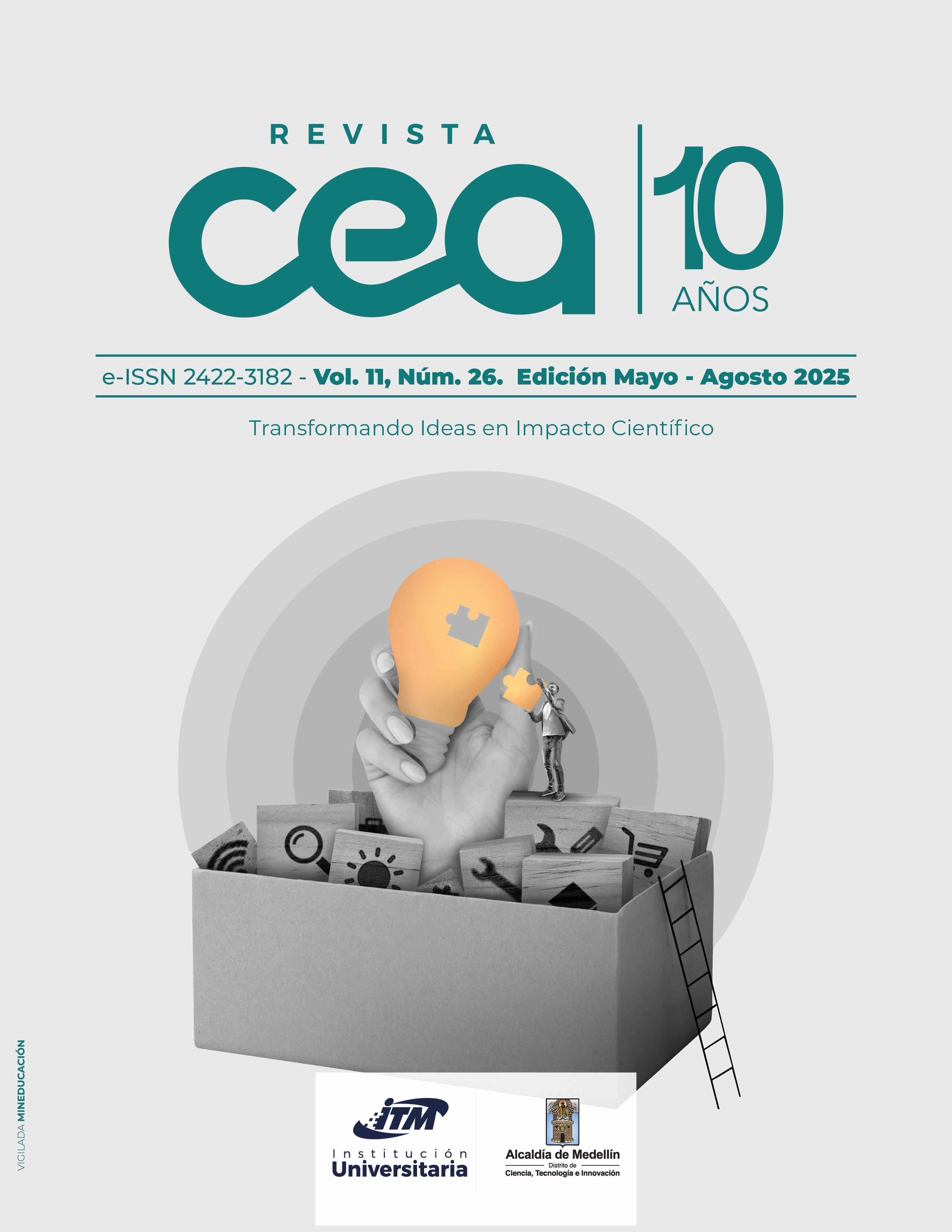Analyzing the Relationship Between Dynamic Capabilities and the Productivity and Competitiveness of Industrial Companies
Abstract
Objective: The objective was to propose strengthening the productivity and competitiveness of industrial companies through dynamic capabilities and the design of an improvement plan.
Design/Methodology: A quantitative, descriptive, correlational, explanatory, cross-sectional, and non-experimental design was adopted. The sample comprised 52 medium-sized and large companies in the industrial sector of Ibagué (Colombia). Data was collected through a structured questionnaire consisting of 28 questions, with variables grouped into three dimensions: dynamic capabilities, productivity, and competitiveness. Following data collection, both descriptive and multidimensional analyses were performed using SPSS 25 and Minitab 18.
Results: The findings reflected that the dynamic capabilities with the greatest impact outcomes achieved, competitive processes, qualified human talent, organizational culture, process reconfiguration, supplier relationships, sector development, customer recognition programs, customer satisfaction, and competitive costs. Regarding productivity, the most influential variables were outcomes achieved, customer satisfaction, and customer recognition programs. Meanwhile, in relation to competitiveness, the variables with the greatest influence were incentive programs, the ability to identify advantages, and competitive processes.
Conclusions: The dynamic capabilities that most strongly influence organizational outcomes include teamwork, innovation, strategic decision-making, and customer recognition programs. These capabilities demonstrated a positive relationship with both productivity and competitiveness. Therefore, an improvement plan is proposed to strengthen dynamic capabilities, using the European Foundation for Quality Management (EFQM) model.
Originality: This research contributes to the current body of knowledge on dynamic capabilities by clarifying their relationship with business productivity and competitiveness. Moreover, based on the current situation of companies in the industrial sector, it identifies which capabilities stand out the most. Additionally, the study offers practical value through the design of an improvement plan that can be implemented across organizations in general, and industrial companies in particular.
References
Arredondo Hidalgo, M. G., Caldera González, D. d. C., y Ortega Carrillo, M. A. (2022). Mejores prácticas y excelencia empresarial. Análisis de una PYME exportadora mexicana. Recherche en Sciences de Gestion-Management Sciences, 153(6), 33-64. https://doi.org/10.3917/resg.153.0033
Bari, N., Chimhundu, R., y Chan, K. C. (2024). Interrelation between sustainable dynamic capabilities, corporate sustainability, and sustained competitive advantage. Sustainability, 16(7), 2864. https://doi.org/10.3390/su16072864
Barreto, I. (2010). Dynamic capabilities: A review of past research and an agenda for the future. Journal of Management, 36(1), 256-280. https://doi.org/10.1177/0149206309350776
Beckhard, R., y Pritchard, W. (1992). Changing the essence: The art of creating and leading fundamental change in organizations (1a. ed.). Jossey-Bass.
Bernal, C. A. (2016). Metodología de la investigación. Pearson.
Bitencourt, C., Neto, H. F. M., y Zanandrea, G. (2024). A (re)view of dynamic capabilities: origins and future developments. RAE – Revista de Administração de Empresas, 64(4), 1-22. https://dx.doi.org/10.1590/S0034-759020240401
Bornay-Barrachina, M., López-Cabrales, A., y Salas-Vallina, A. (2023). Sensing, seizing, and reconfiguring dynamic capabilities in innovative firms: Why does strategic leadership make a difference? BRQ–usiness Research Quarterly, 28(2), 399–420. https://doi.org/10.1177/23409444231185790
Bravo Ibarra, E., Mundet Hiern, J., y Suñé, A. (2007). Un nuevo enfoque para el estudio de la teoría de las capacidades dinámicas. Revista de Economía y Empresa, 21(51), 11-32. https://hdl.handle.net/2117/2985
Chen, Y., Spohrer J., y Lelescu, A. (2008). Three Factors to Sustainable Service System Excellence: A Case Study of Service Systems [conferencia]. 2008 IEEE International Conference on Services Computing, Honolulu, EE.UU. IEEE. https://ieeexplore.ieee.org/xpl/conhome/4578428/proceeding
Cockburn, I. M., Henderson, R. M., y Stern, S. (2000). Untangling the Origins of Competitive Advantage. Strategic Management Journal, 21(10-11), 1.123–1.145. https://www.jstor.org/stable/3094430
Cordero-Salas, P., Chavarría, H., Echeverri, R., y Sepúlveda, S. (2003). Territorios rurales, competitividad y desarrollo. IICA Cuaderno Técnico N° 23. https://hdl.handle.net/11324/7388
Cruz González, J., Navas López, J. E., López Sáez, P., y Delgado Verde, M. (2007). Concepto e Implicaciones de las capacidades dinámicas desde un enfoque de dirección del conocimiento [congreso]. XV Congreso de la Asociación Española de Contabilidad y Administración de empresas, Madrid, España. https://www.aeca1.org/pub/on_line/comunicaciones_xvcongresoaeca/cd/64c.pdf
Delchev, D. (2024). Increasing regional competitiveness through project financing. Strategies for Policy in Science and Education, 32(3), 142-155. https://doi.org/10.53656/str2024-3s-12-inc
Deming, W. E., y Medina, J. N. (1989). Calidad, productividad y competitividad: la salida de la crisis. (1ª. ed.). Ediciones Díaz de Santos.
Diaz Lopez, F. J., Bastein, T., y Tukker, A. (2019). Business Model Innovation for Resource-Efficiency, Circularity and Cleaner Production: What 143 Cases Tell Us. Ecological Economics, 155, 20-35. https://doi.org/10.1016/j.ecolecon.2018.03.009
Eisenhardt, K., y Martin, J. (2000). Dynamic capabilities: What are they? Strategic Management Journal, (21), 1.105-1.121
European Foundation for Quality Management EFQM. (2021). El Modelo EFQM. https://efqm.org/es/the-efqm-model/
Fabrizio, C. M., Kaczam, F., De Moura, G. L., Vieira da Silva, L. S. C., Vieira da Silva, W., y Pereira da Veiga, C. P. (2022). Competitive advantage and dynamic capability in small and medium-sized enterprises: a systematic literature review and future research directions. Review of Managerial Science, 16(3), 617-648. https://doi.org/10.1007/s11846-021-00459-8
Fernández Domínguez, A., y Demmler, M. (2025). Complement and substitution effects of internal migration on foundational competitiveness in Mexico. Mercados y Negocios, 26(54), 13-32. https://doi.org/10.32870/myn.vi54.7769
Fontalvo, T., De la Hoz, E., y Morelos, J. (2018). La productividad y sus factores: incidencia en el mejoramiento organizacional. Dimensión Empresarial, 16(1), 189-202. https://dialnet.unirioja.es/servlet/articulo?codigo=6233008
Galdino da Silva, E. M. S., Weber, A. F., Moreira, M. F., y Da Silva, S. M. (2022). Innovation climate, human capital and dynamic capacities: interrelations between innovation antecedents. Innovation & Management Review, 19(4), 270-289. https://doi.org/10.1108/INMR-06-2019-0087
García Cadena, C. H. (2006). La medición en ciencias sociales y en la psicología. En R. Landero Hernández y M. T. González Ramírez (eds.), Estadística con SPSS y Metodología de la investigación (pp. 139-166). Trillas.
Garzón, M. (2015). Model of dynamic capabilities. Dimensión Empresarial, 13(1), 111-131. http://dx.doi.org/10.15665/rde.v13i1.341
Garzón, M. (2018). La capacidad dinámica de aprendizaje. Desarrollo Gerencial, 10(1), 29-47. https://doi.org/10.17081/dege.10.1.3009
Gutiérrez García, M. A. (2023). Plan de mejora para la fase preparatoria de contratación pública de un municipio de la provincia de Los Ríos, Ecuador [tesis de maestría, Universidad César Vallejo]. Repositorio UCV. https://repositorio.ucv.edu.pe/bitstream/handle/20.500.12692/110243/Guti%c3%a9rrez_GMA-SD.pdf?sequence=1&isAllowed=y
Helfat, C., y Raubitschek, R. (2000). Product Sequencing: Co-Evolution of Knowledge, Capabilities and Products. Tuck-JFE Contemporary Corporate Governance Conference. http://dx.doi.org/10.2139/ssrn.237288
Hernández Lugo, A. (2003). Organización de la producción y del trabajo: Gestión por procesos. Industrial, 24(1), 21-24.
Hernández Sampieri, R., Fernández Collado, C., y Baptista Lucio, P. (2014). Metodología de la investigación (6a. ed.). McGraw-Hill.
Hill, C., y Jones, G. (2004). Administración estratégica. Un enfoque integrado. McGraw-Hill.
Ibidunni, A., y Nnaemaka, C. G. (2025). The role of entrepreneurial resourcefulness and dynamic capabilities on student´s entrepreneurial intention. RAE – Revista de Administração de Empresas, 65(2), 1-25. https://doi.org/10.1590/S0034-759020250207
Maderuelo Fernández, J. A. (2002). Gestión de la calidad total: El modelo EFQM de excelencia. Medifam, 12(10), 41-54. https://scielo.isciii.es/scielo.php?script=sci_arttext&pid=S1131-57682002001000004
Mendivil-Hernández, P., González-Sánchez, E., Gutiérrez-Calderón, M. A., Herazo-Chamorro, M., Cogollo-Dueñas, J. F., y Bravo-Chadid, N. J. (2025). The qualification of human capital as a productivity factor in organizations. Revista de Gestão Social e Ambiental-RGSA, 19(2), e011430. https://doi.org/10.24857/rgsa.v19n2-118
McKelvie, A., y Davidsson, P. (2009). From resource base to dynamic capabilities: An investigation of new firms. British Journal of Management, 20(1), S63-S80. https://doi.org/10.1111/j.1467-8551.2008.00613.x
Mishra, P., y Yadav, M. (2021). Environmental capabilities, proactive environmental strategy and competitive advantage: A natural-resource-based view of firms operating in India. Journal of Cleaner Production, 291, 125-249. https://doi.org/10.1016/j.jclepro.2020.125249
Moon, S., y Lee, H. (2021). Shaping a circular economy in the digital tv industry: focusing on ecopreneurship through the lens of dynamic capability. Sustainability, 13(9), 4865. https://doi.org/10.3390/su13094865
Mushangai, D. (2023). Dynamic capabilities: Axiomatic formation of firms’ competitive competencies. Social Sciences & Humanities Open, 8(1), 100654. https://doi.org/10.1016/j.ssaho.2023.100654
Mustafa, B., y Lleshi, S. (2024). The impact of lifelong learning and investments in employee development on employee productivity and performance. Multidisciplinary Reviews, 7(8), 2024175. https://doi.org/10.31893/multirev.2024175
Niehaus, M., Hansen, K., Mocan, M., y Barmayoun, D. (2023). Unraveling successful company organizations: A research design to explore strategies for thriving amid market turbulence. Administrative Sciences, 13(9), 204. https://doi.org/10.3390/admsci13090204
Orellana López, D. M., y Sánchez Gómez, M. C. (2006). Técnicas de recolección de datos en entornos virtuales más usadas en la investigación cualitativa. Revista de Investigación Educativa, 24(1), 205-222. https://revistas.um.es/rie/article/view/97661
Ortega Álvarez, A. M., García Merino, T., y Santos Álvarez, M. V. (2012). El desarrollo de nuevos productos a la luz y a la sombra de las capacidades dinámicas. Cuadernos de Administración, 25(45), 113-135. https://doi.org/10.11144/Javeriana.cao25-45.dnpl
Parasuraman, A., Zeithaml, V. A., y Berry, L. L. (1985). A Conceptual Model of Service Quality and its Implications for Future Research. Journal of Marketing, 49(4), 41-50. https://doi.org/10.2307/1251430
Pardo-Rozo, Y. Y., Carvajal-Valderrama, G., y Perdomo-Carvajal, A. (2024). Evaluación de la Responsabilidad Social Empresarial en supermercados de Florencia, Caquetá, Colombia como factor de competitividad. Repositorio de la Red Internacional de Investigadores en Competitividad, 17(17). https://www.riico.net/index.php/riico/article/view/2227
Porter, M. E. (1991). Towards a dynamic theory of strategy. Strategic Management Journal, 12(S2), 95-117. https://doi.org/10.1002/smj.4250121008
Porter, M. (2017). Ser competitivo (9a. ed.). Deusto.
Porter, M. (2021). The changing role of business in society. Working paper.
Prabowo, H., Sriwidadi, T., y Ikhsan, R. B. (2021). The influence of dynamic capability on sustainable competitive advantage: An empirical study of small businesses in Indonesia. The Journal of Asian Finance, Economics and Business, 8(6), 949-959. https://doi.org/10.13106/jafeb.2021.vol8.no6.0949
Proaño Villavicencio, D.X., Gisbert Soler, V., y Pérez Bernabeu, E. (2017). Metodología para elaborar un plan de mejora continua. 3C Empresa: investigación y pensamiento crítico, Edición Especial, 50-56. https://3ciencias.com/wp-content/uploads/2018/01/art_6.pdf
Rajnoha, R., y Lesnikova, P. (2022). Sustainable competitiveness: how does global competitiveness index relate to economic performance accompanied by sustainable development? Journal of Competitiveness, 14(1), 136-154. https://doi.org/10.7441/joc.2022.01.08
Salazar, A., y Peláez, E. (2012). The organic growth of dynamic capabilities for innovation. International Journal of Technology Management and Sustainable Development, 10(3), 231.250. https://doi.org/10.1386/tmsd.10.3.231_1
Sánchez Martínez, D., Lavín Verastegui, J., Pedraza Melo, N. A., y Jasso, J. (2025). Capacidades dinámicas y economía circular en las organizaciones: un análisis bibliométrico. Revista Mexicana de Economía y Finanzas, 20(1), 1-33. https://doi.org/10.21919/remef.v20i1.1198
Schilke, O. (2014). On the contingent value of dynamic capabilities for competitive advantage: the nonlinear moderating effect of environmental dynamism. Strategic Management Journal, 35(2), 179-203. https://doi.org/10.1002/smj.2099
Segura Rodríguez, J. G. (2020). Implementación de dashboards con uso de indicadores para mejorar la productividad del servicio: acondicionamiento de ambientes para actividades productivas en el EP Chorrillos comunes [tesis de grado, Universidad Antenor Orrego]. https://hdl.handle.net/20.500.12759/6733
Teece, D. J., Pisano, G., y Shuen, A. (1997). Dynamic capabilities and strategic management. Strategic Management Journal, 18(7), 509-533. https://www.jstor.org/stable/3088148
Trianni, A., Cagno, E., Dolšak, J., y Hrovatin, N. (2021). Implementing energy efficiency measures: ¿do other production resources matter? A broad study in Slovenian manufacturing small and medium-sized enterprises. Journal of Cleaner Production, 287, 125044. https://doi.org/10.1016/j.jclepro.2020.125044
Ulloa-Pimienta, A. R., Sánchez-Trinidad, A. d. C., y Balcazar-Sosa, M. T. d. J. (2023). La productividad en la empresa de la industria de la transformación. Revista de Investigaciones Universidad del Quindío, 35(1), 236-247. https://doi.org/10.33975/riuq.vol35n1.1156
Uribe Macias, M. E. (2017). Gerencia del servicio: Alternativa para la competitividad (3a. ed.). Ediciones de la U.
Uribe Macias, M. E. (2020). Responsabilidad social empresarial. Ediciones de la U.
Uribe Macias, M. E. (2021). Administración estratégica. Modelo de aplicación para las organizaciones latinoamericanas. Ediciones de la U.
Veluthedan, S. P., y Kiran, K. B. (2024). Digital financial services (DFS) and productivity of Indian banking sector – empirical evidence using Malmquist productivity index and panel data regression. Revista de Gestão Social e Ambiental, 18(8), e06167. https://doi.org/10.24857/rgsa.v18n8-002
Vivas-López, S. (2013). Implicaciones de las capacidades dinámicas para la competitividad y la innovación en el Siglo XXI. Cuadernos de Administración, 26(47), 119-139. https://www.redalyc.org/pdf/205/20531182006.pdf
Zahra, S., y George, G. (2002). Absorptive capacity: a review, conceptualization, and extension. Academy of Management Review, 27(2), 185-203. https://www.jstor.org/stable/4134351
Zajac, E. J., Kraatz, M. S., y Bresser, R. K. (2000). Modeling the dynamics of strategic fit: A normative approach to strategic change. Strategic Management Journal, 21(4), 429-453. https://doi.org/10.1002/(SICI)1097-0266(200004)21:4<429::AID-SMJ81>3.0.CO;2-%23
Zapata Rotundo, G. J., y Mirabal Martínez, A. (2018). Capacidades dinámicas de la organización: revisión de la literatura y un modelo propuesto. Investigación Administrativa, 47(121), 47-70. https://www.redalyc.org/articulo.oa?id=456054552003
Zollo, M., y Winter, S. G. (2002). Deliberate learning and the evolution of dynamic capabilities. Organization Science, 13(3), 339-351. https://www.jstor.org/stable/3086025
Downloads
Copyright (c) 2025 Angélica María Horta Lázaro, Mario Enrique Uribe Macías, Germán Rubio Guerrero

This work is licensed under a Creative Commons Attribution-NonCommercial-ShareAlike 4.0 International License.

| Article metrics | |
|---|---|
| Abstract views | |
| Galley vies | |
| PDF Views | |
| HTML views | |
| Other views | |







